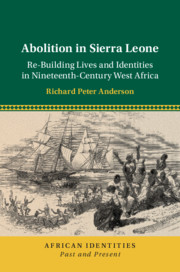Book contents
- Abolition in Sierra Leone
- African Identities: Past and Present
- Abolition in Sierra Leone
- Copyright page
- Dedication
- Contents
- Illustrations
- Acknowledgments
- Notes on the Text
- Abbreviations
- Introduction
- 1 Liberated African Origins and the Nineteenth-Century Slave Trade
- 2 Their Own Middle Passage
- 3 “Particulars of disposal”
- 4 Liberated African Nations
- 5 Kings and Companies
- 6 Religion, Return, and the Making of the Aku
- 7 The Cobolo War
- Conclusion
- Appendices
- Select Bibliography
- Index
7 - The Cobolo War
Islam, Identity, and Resistance
Published online by Cambridge University Press: 09 January 2020
- Abolition in Sierra Leone
- African Identities: Past and Present
- Abolition in Sierra Leone
- Copyright page
- Dedication
- Contents
- Illustrations
- Acknowledgments
- Notes on the Text
- Abbreviations
- Introduction
- 1 Liberated African Origins and the Nineteenth-Century Slave Trade
- 2 Their Own Middle Passage
- 3 “Particulars of disposal”
- 4 Liberated African Nations
- 5 Kings and Companies
- 6 Religion, Return, and the Making of the Aku
- 7 The Cobolo War
- Conclusion
- Appendices
- Select Bibliography
- Index
Summary
The concluding chapter follows the buildup, instigation, suppression, and legacies of the Cobolo War, an 1832 conflagration that marked the largest flashpoint between Liberated Africans and the colonial state. During the war, a group of “Mahomedan Aku” (Yoruba Muslim) Liberated Africans, who had previously vacated the colony temporarily, defeated a colonial militia instructed to bring the fugitives back to Freetown. The actions of these Aku Liberated Africans were contemporaneous with a pattern of violent resistance to colonial oppression instigated by Yoruba speakers around the Atlantic world in the 1820s and 1830s. Although eventually defeated, the conflict at Cobolo had long-standing legacies. In the months and years after the battle – and a failed attempt to try the leaders for treason – British officials embarked on a campaign of intimidation and repression, toppling mosques that Muslim Liberated Africans had built as they moved into communities to ensure their religious autonomy. This chapter traces the relationship between Muslim and ethnic identity in the context of colonial oppression, the role of Islam in shaping the conceptual meaning of “Aku,” and the endurance of Muslim Liberated African communities over subsequent generations of Sierra Leonean history.
Keywords
- Type
- Chapter
- Information
- Abolition in Sierra LeoneRe-Building Lives and Identities in Nineteenth-Century West Africa, pp. 227 - 259Publisher: Cambridge University PressPrint publication year: 2020

